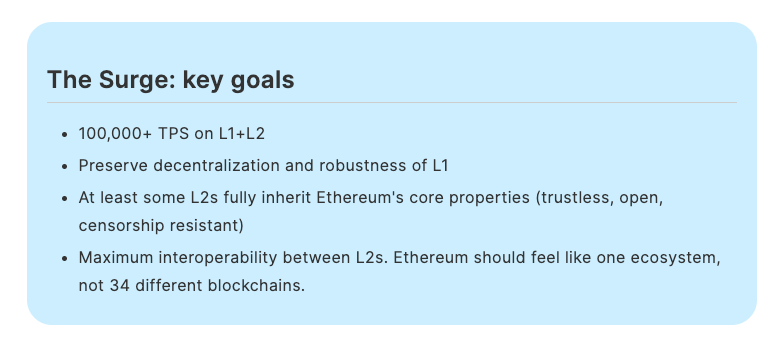Ethereum Surge: Buterin Aims For 100K Tps With Layer 2 Interoperability

Vitalik Buterin outlines Ethereum “Surge” goals, aiming for over 100,000 TPS across Layer 1 and Layer 2 chains while enhancing interoperability between Layer 2s, creating a unified ecosystem.
Ethereum co-founder Vitalik Buterin has revealed his ambitious goals for the next phase of Ethereum’s roadmap, known as the “Surge.” The main objective? Achieving over 100,000 transactions per second (TPS) across Ethereum’s mainnet and its Layer 2 (L2) chains while making the ecosystem feel more unified. In an October 17 blog post, Buterin detailed the key milestones of the Surge, aiming to build a more scalable, interoperable blockchain network that operates as a single, cohesive ecosystem.
Online advertising service 1lx.online
Buterin highlighted the importance of bridging the gaps between Ethereum’s Layer 1 (L1) and Layer 2 chains, stating that “Ethereum should feel like one ecosystem, not 34 different blockchains.”

Ethereum Road to 100,000 TPS
One of the primary goals of the Surge is to significantly scale Ethereum’s transaction capacity across both its mainnet and Layer 2s. Buterin emphasized that Ethereum has already made strides in this direction, thanks to its rollup-centric roadmap, which was recently enhanced by the Dencun upgrade in March. This upgrade, combining Shanghai and Cancun-Dened improvements, lowered fees on L2 networks and made data usage more efficient through the introduction of “blobs.”
Despite these advancements, Buterin acknowledged that Ethereum still faces challenges, particularly when it comes to data availability and improving the trustlessness of L2s. To continue scaling Ethereum, Buterin believes the network must address these areas to maintain security and decentralization, all while boosting transaction speed.
Scaling Ethereum While Maintaining Decentralization
A crucial aspect of Buterin’s roadmap involves scaling Ethereum’s L1 chain to keep up with the rising demand from L2s. He warned that if Ethereum’s L1 remains limited in its capacity to process transactions, it could expose the network to risks, even as L2s become more scalable.
One of the potential solutions Buterin proposed was increasing Ethereum’s gas limit. However, he recognized the centralization risks involved with this approach, as higher gas limits could drive up costs for stakers. As an alternative, Buterin suggested making specific computations more affordable without sacrificing decentralization. These include multidimensional gas pricing, reducing gas costs for certain operations, and introducing new bytecode formats.
Enhancing Layer 2 Interoperability and User Experience
Buterin also stressed the need to improve the user experience across Ethereum’s Layer 2 networks, noting that these chains should function seamlessly with one another to provide users with a unified Ethereum experience. He pointed out that Layer 2 networks should allow for smoother interactions, where users can move tokens across chains without complex bridging or swapping processes.
“If we are serious about the idea that L2s are part of Ethereum, we need to make using the L2 ecosystem feel like using a unified Ethereum ecosystem,” Buterin said.
By streamlining communication between L2s in the backend, Ethereum would ease the technical burden on users and make cross-chain transactions more intuitive.
The Rollup-Centric Roadmap: Ethereum’s Evolution
Ethereum’s development has undergone significant changes over time. Originally, the Ethereum 2.0 roadmap envisioned scaling Ethereum through sharding, which would essentially create multiple Ethereum blockchains operating simultaneously. However, in 2020, Buterin shifted focus toward a rollup-centric roadmap, leveraging Optimistic and ZK-rollups to offload computation and execution to L2s while retaining Ethereum’s core security features.
In his blog post, Buterin reaffirmed Ethereum’s commitment to this roadmap, stating, “Now our task is to bring the rollup-centric roadmap to completion and solve these problems while preserving the robustness and decentralization that makes the Ethereum L1 special.”
As Ethereum pushes toward the Surge and its goal of 100,000 TPS, the success of this rollup-centric approach will be critical in ensuring that Ethereum remains a scalable and decentralized platform, prepared for the growing demands of decentralized finance (DeFi) and Web3.
Unser Schöpfer erstellt erstaunliche NFT-Sammlungen!
Unterstütze die Redakteure - Bitcoin_Man (ETH) / Bitcoin_Man (TON)
Binance – 100$ gratis (exklusiv): Melden Sie sich über diesen Link an und erhalten Sie 100 $ gratis und 10 % Rabatt auf Ihre Binance Futures-Gebühren für den ersten Monat (Allgemeine Geschäftsbedingungen).
Bitget – Nutzen Sie diesen Link, nutzen Sie das Rewards Center und gewinnen Sie bis zu 5027 USDT!
(Rezension)
Registrierung OHNE SANKTIONSRISIKO an der Bybit-Börse: Verwenden Sie diesen Link (alle möglichen Rabatte auf Provisionen und Boni bis zu 30.030 USD inbegriffen). Wenn Sie sich über die Anwendung registrieren, geben Sie bei der Registrierung einfach in das Referenzfeld ein: WB8XZ4 - (manuell)
Quelle – Übersetzt und veröffentlicht ✓

